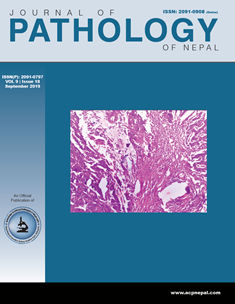Patient-Pathologist Consultation
DOI:
https://doi.org/10.3126/jpn.v9i2.26713Keywords:
Laboratory, Patient, Pathologist, ReportsAbstract
Pathologists are being considered as “Doctor’s doctor”, the reason is not they are far more knowledgeable or experienced than the treating physicians. The only reason is for decades, the only bridges between the patient and Pathologists are the treating physician. Many times, the patient suffering from cancer, doesn’t know that the confirmed diagnosis was not given by the treating physician but by the Pathologist. The input of the pathologist (and radiologist) is often essential to a proper diagnosis, yet rarely is the patient given those reports and rare access to the reporting individuals. To date, Pathologists are advising clinical colleagues on appropriate tests, result-interpretation, follow-up testing and to reach the diagnosis. Various clinico-pathological meetings help in overcoming this hurdle.
However, in this era of expanding, decentralized health systems and rapidly increasing the complexity of newer laboratory tests, diagnostic algorithms, and guidelines, it is being difficult for treating physicians to stay updated, even in the area of their expertise. One survey of laboratory utilization patterns revealed that primary care physicians were uncertain of up to 23% of tests utilized, with test ordering uncertainty in 14.7% and test interpretation uncertainty in 8.3%. The 2015 Institute of Medicine report, “Improving Diagnosis in Healthcare” recognizes diagnosis as a team effort that requires pathologist input and interaction with clinical colleagues. Educating and providing consultation is a role that pathologists must embrace. On top of this, social media is beginning to change the way that medicine is practiced. It has the power to engage people in public health and policy discussions, establish professional networks and facilitate patients’ access to information about health and services.
We have integrated social media into our lives by choice and we in the medical practice, amidst our busy schedules, have been using it for easy connectivity with friends and families and also, if not important, for our continued education.3 Various information is available about any disease conditions and available diagnostic methods. Once a patient gets his/her report, they tend to surf on the internet and an overwhelming amount of information present on the internet may not only confuse the patient but also lead to anxiety by going through all the possible consequences which rarely occur. Furthermore, histopathological or cytological reports are better explained by the reporting pathologists. Sometimes, it becomes difficult for treating physicians to explain what exactly does “suggestive of” or “Suspicious” means and what to do next. Limitations and the superiority of any diagnostic tool are better understood by the pathologists. All the issues can be settled with patient-pathologist direct communications. This will help the patient to know the details regarding the test, it’s limitations and its superiority. Direct patient-pathologist communication greatly decreases the burden of treating physicians in counseling the patients., helps to further explain the relevance of the tests and results and have a positive impact on their health and healthcare choices.
Downloads
Downloads
Published
How to Cite
Issue
Section
License
This license enables reusers to distribute, remix, adapt, and build upon the material in any medium or format, so long as attribution is given to the creator. The license allows for commercial use.




